Rod Wallace: Are the bulk of the horses shod by contract?
Rob: Yes, the ones that are going to the parks. Each park is responsible to shoe their own horses. There is a contract shoer for Banff and he usually comes out here and shoes them at the ranch for their first shoeing of the year. The Jasper horses are all shipped to Jasper and most of them are shod in Jasper by their own contactor and some by Jim Chesser (Jasper Barn Boss).
Marie: Did you know or meet Cal Hayes?
Rob: Yes. I ran into Cal a few times when I was working for Ron Warner. About the second year that I was working for Ron I was coming out from what they call a ‘moving trip’. The way moving trips worked was that we’d start the trip at one area and end it at a different area. So this one trip finished up at the Ya Ha Tinda (Bighorn Campground). Generally the trips were set up back-to-back so usually you’d pick up another group of tourists and make the trip in the reverse. But this particular time there was no booking for a return trip. So this meant that the horses had to be hauled back to Banff. At the time, all Ron had to haul with was a 3-ton truck so we needed a loading ramp and the only ramp available at the time was at the ranch buildings. Anyways, I was with the cook and the pack mules and I was ahead of the guests and the guide. The Holiday On Horseback office in Banff had told me when you get to the Ya Ha Tinda Ranch just ride up to the buildings (and someone will pick you and the horses up) and we will let Cal know you are coming. And it should not have been a big deal. ButI guess someone forgot to phone Cal, or someone was playing a joke on me, because Cal had quite a reputation. Anyways I just rode up there, brazen as all heck and I rode through the gate and led this string of pack mules into the yard with the cook behind me and I rode right up to the barn. There was nobody around that I could see. I was looking around to see if I could see anyone and started to step down off my horse to tie my animals up to the fence. Suddenly I hear this big bellow. “Hey you! Get up here! Bring those jackasses with you!” So, I rode up the hill to his little house there and Cal proceeded to tear a strip off me. I never got a word in edgewise. Finally, he asked me what I was doing there and I told him. He said, “Nobody called me about it. When are they coming and who is coming?” I told him, Lee Robinson. “Oh yeah, that guy.” So, he says, “Okay, let’s take them down to the barn.” So, we take all these mules down to the barn and he had me bring them all into the barn. We unpacked them inside the barn and put them all in stalls. Cal gave them some oats and all this kind of stuff and just about the time we were finishing up, I could see the dust coming and it was Lee coming with the truck. The guide still was not there with the tourists. Cal said, “Come on.” And he took us into the bunkhouse and then he said, “Now you stay in here.” And he closed up the barn doors and we sat in the cabin looking out the window watching Lee get lined up on the loading ramp. Lee did not think we were there yet as there were no animals visible in the yard. So he backed up to the loading ramp. Cal waited until Lee was almost backed in there and then he hollered “Hey you in the red truck! What the hell do you think you are doing?” And proceed to give Lee the same lecture he had gave me. So it was quite entertaining. Then, after that Cal kind of knew what the schedule was and he’d usually end up coming down to the staging area for a visit.
Cal actually phoned me every time there was an opening there. He’d kind of taken a liking to me and would let me know when there was an opening and asked if I was interested in a job there. I actually enjoyed Cal quite a bit. He was a character. Steve Bennett has some great stories about Cal.
Marie: Jordan, what do you remember about your life at the Ya Ha Tinda?
Jordan: I don’t really remember. I was too young. I still go there every year for a horse camping holiday. Usually we go camping with our friends and just ride to places on the ranch.
Marie: It is a pretty special place to go back to.
Sue: They found a swimming hole on the backwater of the river and it is deep enough to swim their horses. They go in there on a warm day and swim.
Jordan: But my horse, Elko, doesn’t really like it. He tries to climb up the bank to get out.
Shelby: We need to haul a tree out of the hole this year as it is in the way of the horses swimming.
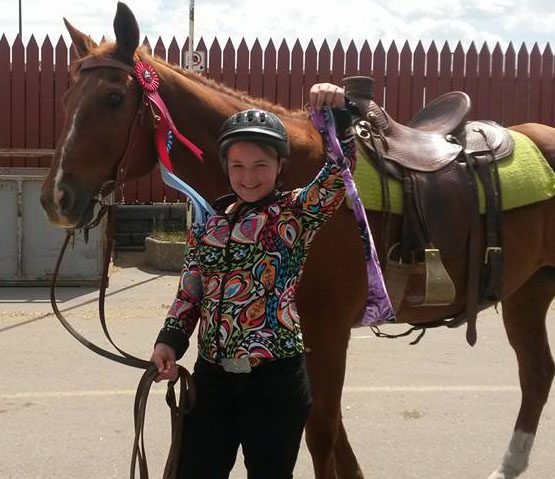
Jordan Jennings and Elko and their horse show ribbons.
Rob – Jordan’s horse is a retired patrol horse. The photos and plaques on the wall here are of Jordan’s achievements with Elko in horse shows and 4-H.
Marie: Elko was one the first colts sired by the registered quarter horse stallion “Hands Off Hans” (Arrow) and a registered quarter horse mare. He is a purebred quarterhorse. Elko was Chief Warden Ian Syme’s patrol horse for many years. When he was retired as a patrol horse one of the local outfitters bought him but he didn’t work out so he eventually ended up belonging to Jordan. She’s won a lot of ribbons and awards on Elko.
Rob: She picked up a “first place” in Calgary last year at 4-H On Parade.
Rob: Elko doesn’t mind packing flags or anything and the girls use him in the Sundre Pro Rodeo sometimes.
Sue: Jordan will be using him this year with the “Go Wild Go West” drill team at the Sundre Rodeo in June.
Rod Wallace: Do you ride with the drill team in the Dog Pound Rodeo too?
Shelby: No, just the Sundre Rodeo. Most rodeos have their own drill team. There are very few that will ask for another team to come in.
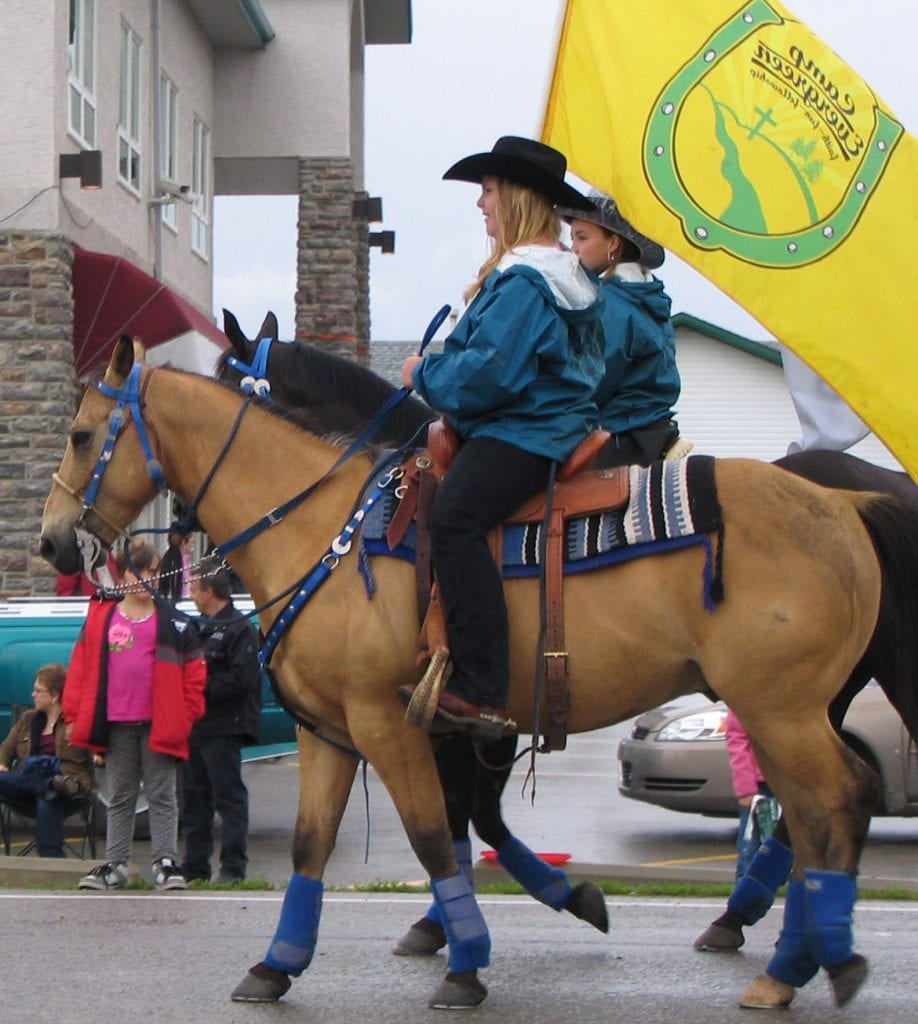
Shelby participating in the Sundre Rodeo Parade with the drill team.
Marie: So, girls you will both be on the drill team this year. That is great. You have a good foundation with horses having lived at the Ya Ha Tinda and having been involved in the 4-H Equestrian discipline and having your dad as a dedicated horseman.
Rod Wallace: What about someone like Slim Haugen. Was he (at the ranch) before your time?
Rob: Yes, but I first met Slim when I was a child. He was a family friend of my parents, and a close friend of the Dixons. When I got to know him a bit he would come down to Riding Mountain to visit Fred and Ann. They’d always bring him over to our place to visit. I was around him a little bit. He was the manager of the Ya Ha Tinda for quite a few years after the Dixons left. Mickey Gilmar was there at some point after the Dixons. Slim was the manager when Johnny was the Barn Boss in Banff. (Ya Ha Tinda Ranch foremen were: Fred Dixon 1954 to 1957. Mickey Gilmar 1958 to 1964. Don Sutherland 1964 to 1967. Bill Burles 1968. Slim Haugen 1969 to 1982.)
Marie: In his early days Slim had a long history working at the Douglas Lake Ranch.
Rod: Was Slim the Barn Boss in Banff for a while?
Rob: No. He was with Parks for a long time, but worked in Yoho Park as Barn Boss and packer.
Jim Burles was Barn Boss in Banff for a long time and then Johnny took over from him. Jim Burles taught me how to shoe horses. I didn’t really shoe the horse; Jim would put the shoe on and then he’d let me drive a few nails. This was when I was about ten years old.
Marie: Jim Burles was another character that unfortunately has passed on. He had many interesting experiences and stories.
Rob: When he got older, you didn’t want to get behind him in traffic. He didn’t go along with modern day Banff. He’d move at the same speed that he drove in the 1950s. Jim was around a lot when I was a kid. He was one of my heroes then too. He was a cowboy. He was still shoeing his horse in his 80s. They said the last year that he had his horse in Banff it took him four days to shoe his horse – he’d put one shoe on a day, but he got the job done .
Rod Wallace: His son Doug Burles was a long time park warden.
Rob: Yes, Doug was in Riding Mountain for a short time.
Marie: Did any of you feel it was too isolated for you at the Ya Ha Tinda?
Sue: No. You know the only time I felt isolated was during the flood and the road washed out. That was really the only time. Even in the winter there was always things to do and there was always people around.
Rob: In 2005 and 2013 were years where heavy rains caused washouts on Eagle Creek.
Sue: One time when we were coming home we got to Eagle Creek. I was driving. We get to the creek and the culvert has washed away. There is two guys on the other side of the creek and they managed to come through the water and made it across. But we couldn’t see there was a big washout of the bank on the far side. Those guys had dropped down off that bank and came across. So, we hit this bank going the other way and it stopped the truck. Rob hopped out into the water and told me to stay in the truck with Shelby and Jordan. The kids were both really little then, and our dogs were in the back of the truck. We had a topper on the truck. The truck started to wash down stream and I thought to myself, “I am not going to be washed down into the Red Deer River so I grabbed the kids, and I got out into the water and threw the kids up onto the bank. Shelby was concerned about the dogs so Rob rescued them from the back of the truck. That was very scary.
Rob: The road now is the best it has ever been. This past year Clearwater County has hired a grader contractor who has his own grader and he is doing a great job on the road. He has widened the road and made put pullouts and really does an incredible job.
Marie: You folks have seen an awful lot of change on the ranch with what the Red Deer River has done.
Rob: The flat east of the campground has been badly washed away by the river with floods of the past several years. There is changing dynamics there all the time. The Bighorn Campground gets flooded more now.
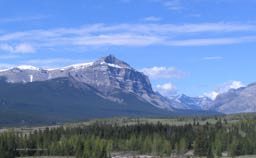
Warden Rock, photo courtesy of Marie Nylund
Rod Wallace: What about the so-called V.I.P.s that come out there. Do you ever have to take them out?
Rob: Not too often. It depends how important they are. But there are not that many really big V.I.P.s. The only one I took out was when Alan Latourelle (Parks Canada Director General) came out. That was an interesting day, and I got to meet him and talk to him. I was quite impressed with the guy. He had a pretty tough job but he explained a lot of stuff to us and made a serious point of talking privately to just Tom (McKenzie) and me. He explained to us right off the bat that despite rumours that the ranch was in jeopardy he was not going to let it happen on his watch. He said that as far as he was concerned horse use was important. He did come to the forefront on that on ‘Black Monday.” When we all had to go to Banff for a meeting to find out what the future of the ranch (and our jobs) and Bill Hunt told us that they were happy with what we were doing and to keep on doing what we were doing (at the ranch). Tom asked if the ranch was on the cutting block and was told that “yes it had been on the cutting block but Alan Latourelle had stepped in and saved that from happening. He was a man of his word. He enjoyed the horses and has rode a lot in Jasper Park with Steve Otway. He seemed like a pretty common sense kind of guy and wanted to know how we select the horses and cull horses etc. There was an injured horse at the ranch during Mr. Latourelle’s visit. The horse had been cut up and I explained to him that this particular horse would not make a patrol horse because if it can’t be sound enough to pull its weight (do the job) then it won’t stay here. Mr. Latourelle made a joke and said he wishes he could do that. He had a sense of humour.
Rod Wallace: That is good to hear that because I hear so many negative things about him.
Rob: I think it is a tough job to be at the top.
Marie: Over your 18 years have you heard a lot of rumours about the possible demise of the ranch?
Rob: Oh yes, it has always been that way. Even as a kid we’d hear talk that certain changes would result in the end of the ranch. I recall my Dad talking about that during the changes to the area management system and centralization. It was thought that these changes would result in the end of the horses. But it never happened. Horse use has been definitely cut back a lot though. Unfortunately, the people that they hire these days don’t have the background to be able to use the horses as much as the horses could be used. They don’t have the knowledge. The other problem is the cutback in manpower. You can’t have horsepower without manpower. At the same time, there has been a resurgence in horse use. For instance, the trail crew staff are starting to use horses more. The sciences are really getting into using them. The Bison project will use horses and Karsten Heuer, who is the project manager, is sending his people that will be working with the bison project, up to the ranch to get trained with horses. It will be the only management tool the team will have once they start releasing the bison.
Rod Wallace: I think the good thing about parks is it is a cyclic kind of thing. Government is in general a cyclic kind of thing.
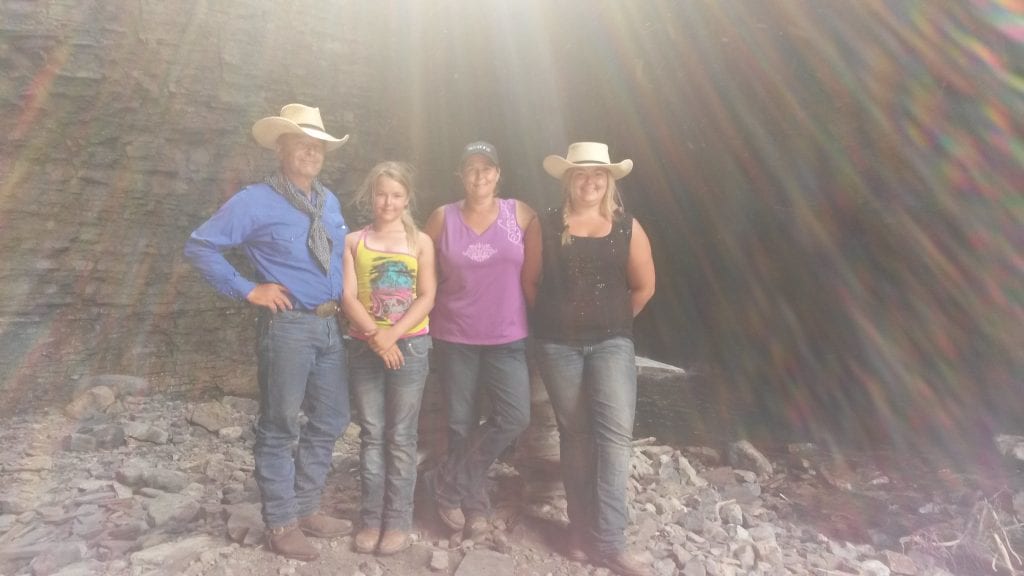
The Jennings family at Hidden Falls.
Marie: Is there an increase in visitation at the Bighorn Campground?
Rob: It has actually dropped a lot over the years and I think that it is in some part due to generational stuff. A lot of the people that were always coming there are now “longer in the tooth” and do not come any more. There seems to be a generational change and most of the people using it now are 50-70 age group. And there is a bit of an influx of younger people starting to use it now. Usage seems to go on a cycle too. There is the odd weekend that was real busy. Long weekends still tend to be busy.
Rod Wallace: I think the outfitters have experienced that generational change too, haven’t they?
Rob: Yes, people are not that geared into the wilderness experience like they were say 30 years ago. People seem to have other interests now, like things involving technology (WiFi). I think that it may be a cyclic thing too; at least I hope it is. I don’t know. Maybe the interest in having technology (as entertainment) will fade and people will get tired of that and go back to nature. The thing I noticed when working for Ron was the longer trips the number of guests were dropping off. It could be that a lot of people these days don’t like roughing it and it is not cheap.
Marie: I suppose the economy these days may have an effect on people’s choices of entertainment.
Rod Wallace: You have bison out there now?
Rob: Yes, this is part of Karsten Heuer’s program (to acquaint the horses with the bison). I had suggested to him to buy some old bison cows from some producer. They got investigating this and found out that it probably wouldn’t be practical because most of those old cows get pretty cranky so they went to the calf system instead. These bison will be kept in the jingle pasture and visitors can drive past and see them and people can ride their horses past the pasture as well in order to acquaint their horses with the bison. I think having the bison there may also bring more people in to the ranch.
Marie: Are visitors still coming for tours of the ranch buildings?
Rob: Yes, but not as much. The tours are not advertised. The tours have to be booked to not interfere with ranch work. It was included in the job descriptions to do tours and this must be scheduled after work hours as it involves overtime.
Marie: Larry Gilmar has donated a framed photo of his brother, Billy, driving two teams of horses hooked to a buck rake putting up hay at the Ya Ha Tinda in the early 1950s. I took some time to prepare an interpretive note on it and will get it out to the ranch in the next few weeks.
Rob: Tom McKenzie has suggested that the old blacksmith shop into an even bigger museum as it would give more space and isn’t being used these days – just for storage. It needs a new floor though.
Rod Wallace: We are all looking forward to the 100th Anniversary celebration in 2017 and the museum at the ranch is certainly going to be a point of interest. As you mentioned that a lot of people have a lot of things to contribute.
Rob: The work that the Warden Service Alumni is collecting to preserve the history of the ranch is very good. Another person who might be interesting to interview is Holger Spaedke also lived here with his wife and two young children. Holger and his wife, Antje, would have a different perspective on living at the Ya Ha Tinda due to their work being of a scientific nature. He did a lot of studies at the ranch and was very supportive of the use of horses while conducting his studies.
Rod Wallace: It has been a real pleasure to meet you folks. Thank you for your hospitality.
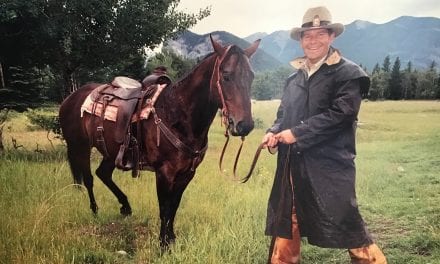
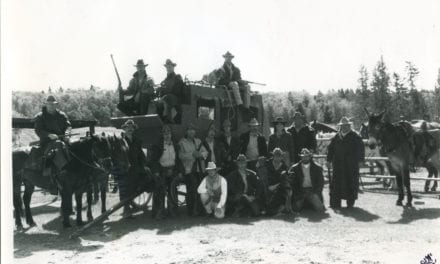
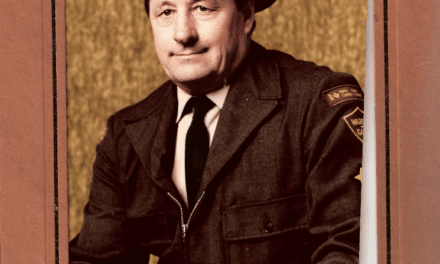
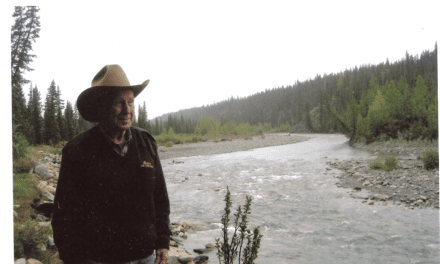
Recent Comments